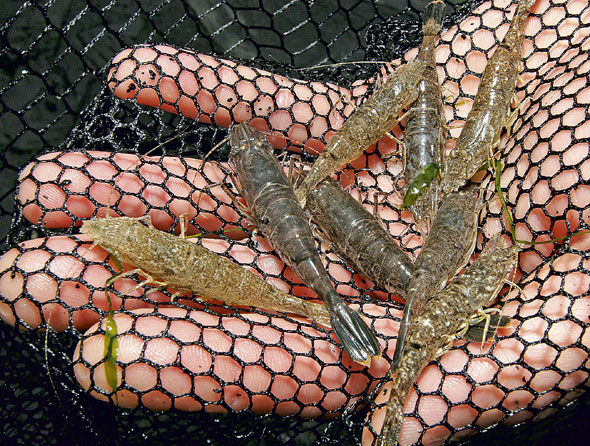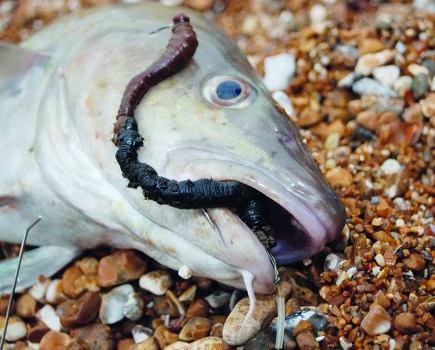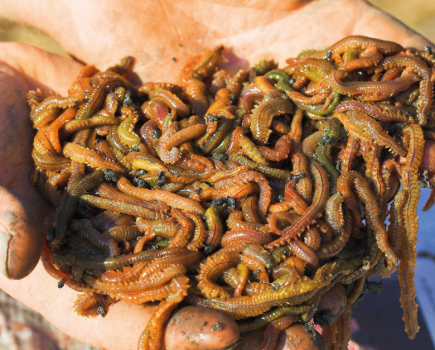Shrimps or prawns?
Well, actually they seem to be the same type of creature. If you buy them in the shops they are all called prawns, regardless of size. In the world of marine biology the bigger ones are generally referred to as prawns and the smaller ones as shrimps, but the real differences in characteristics are difficult to recognise.
I am going to stick with the smaller shrimps and cover the use of the bigger prawns in a future article. There are lots of different types of shrimps throughout UK waters, but the ones of interest to anglers are generally referred to as the common shrimp, brown shrimp or sand shrimp.
They are usually translucent with little colour to them, other than a few faint stripes, and the bigger ones can grow to around 90mm long. In some areas they can be collected in a small net in rock pools, or by pushing a shrimping net along a sandy beach.
A shrimp is a crustacean, just like a crab, and needs to shed its shell to grow bigger, so there will be hardly any fish in the sea that will refuse a soft, juicy shrimp. You just have to look at the stomach contents of cod, bass, whiting, pouting, and probably all of the more popular flatfish species to see that they eat shrimps. Most other species of fish, at least in juvenile form, will probably eat shrimps at some time, and in some parts of the country shrimps will actively take thornback rays and cod.
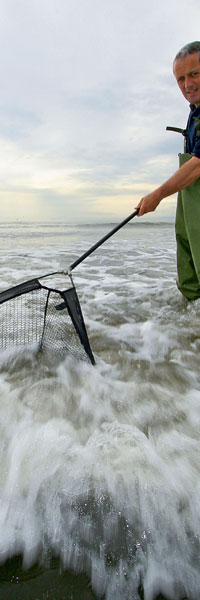 Net types
Net types
A traditional shrimp net has a triangular timber frame with a few struts for strength and a very small-meshed net with a deep drop.
A triangular carp net can be used, but requires a length of timber or metal pipe tied along the bottom end with cable ties to strengthen it – this is the part of the net that makes contact with the bottom and disturbs the shrimps and small flatfish that are then caught in the mesh. This is not as efficient as a proper shrimp net, but it still works.
Time and technique
Shrimps are underrated and not often considered as bait. In some areas they are used for catching estuary flounders and as a cod bait for uptide fishing, when 20 or more whole specimens are threaded up the hooklength, usually in conjunction with lugworms, to make a really big cocktail bait.
Availability, at least of freshly-caught shrimps, seems to be the reason why they are not widely used, but cooked and peeled versions available in the supermarkets are effective as a bait for flatfish and whiting. Most anglers would consider them expensive. Bigger imported prawns are, but smaller ones are not, and £1.25 will buy you around 100g (40 to 50 in number) from your local wet fish shop.
Some anglers might suggest you can get fresh mackerel for a similar price and catch the same fish, but I think that you will be surprised at how effective shrimps can be for certain species. If you net your own supply there is no cost involved. A calm sea in summer, perhaps with just a bit of surf to stir them up, will be the best conditions.
Wade out to around waist depth and push the net along the sea bed in front of you, parallel with the shoreline, making sure you keep in contact with the bottom. Trial and error should tell you when to lift the net for inspection.
A good 50-metre push usually suffices before emptying the contents on to a plastic sheet and sorting out what you want to keep.
Shrimps won’t stay alive for very long, even in oxygenated water, so be prepared to use them soon after capture, cook them to use later, freeze or eat them. The smaller ones can be a bit fiddly to peel, so if you have a good supply it would be better to select the bigger ones for ease of use. Simply snap off the tail section and break open the shell along its length, and the meat should pop out.
How to hook shrimps
Shrimps are quite easy to use either freshly caught, cooked (either peeled or unpeeled), by themselves or as a cocktail. They require a fine-wire hook, such as an Aberdeen pattern.
Hook a few whole specimens through the length of the body and push them up the hook snood, add a few worms or a strip of mackerel and then compress the bait back down on to the hook and use a bait stop, such as a piece of telephone wire, to hold it in place. One or two whole shrimps on a small Aberdeen hook make a scratching bait for flatties or pouting. Tipping it off with a thin strip of mackerel, squid or ragworm makes it even more attractive.
Cooked peeled shrimps are quite tough, but can be of a crumbly texture, so it requires a bit of care to bait up with them. Tie on the elastic thread, but not too tightly because it will cut through the bait, causing it to fall off the hook. Short casting for estuary flounders will be okay – a clipped-down rig will be needed for anything else.
You will need a lot of peeled shrimps to make a big cod bait. Therefore the peeled ones are best as either a bait for smaller species or in a cocktail for bigger quarry. They are also a good bait when floatfishing for small coalfish, pouting and pollack. When used live, the bigger specimens can be hooked lightly through the tail, either alone or in groups of two or three, so that they can move about in the water. They have been known to take bigger pollack and bass when presented like this.
If any of you collect old angling books, as I do, they all tell us that shrimps or prawns of whatever size were a favourite bass bait in the past.
COOKING AND HOOKING
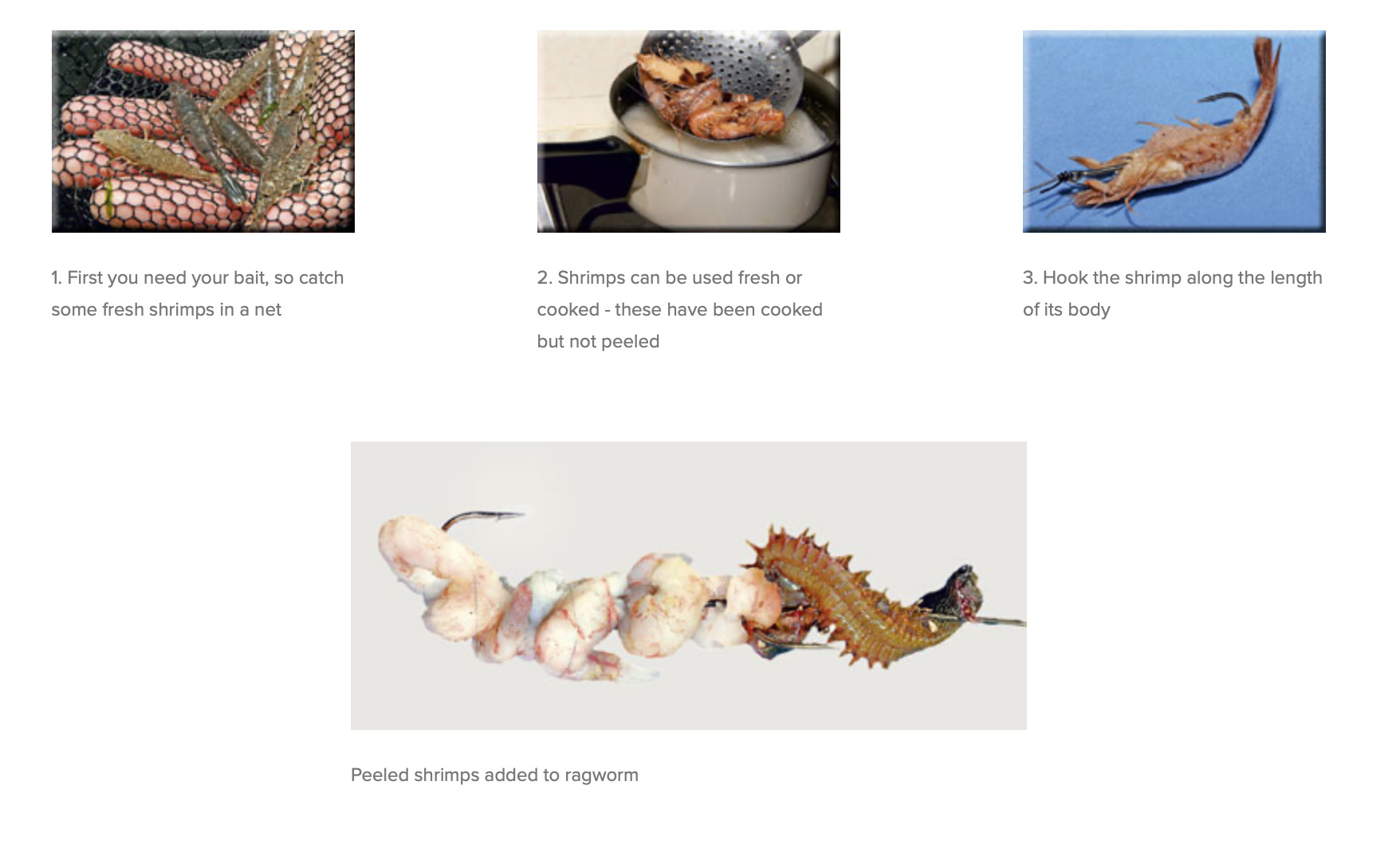
USING UNCOOKED SHRIMPS


